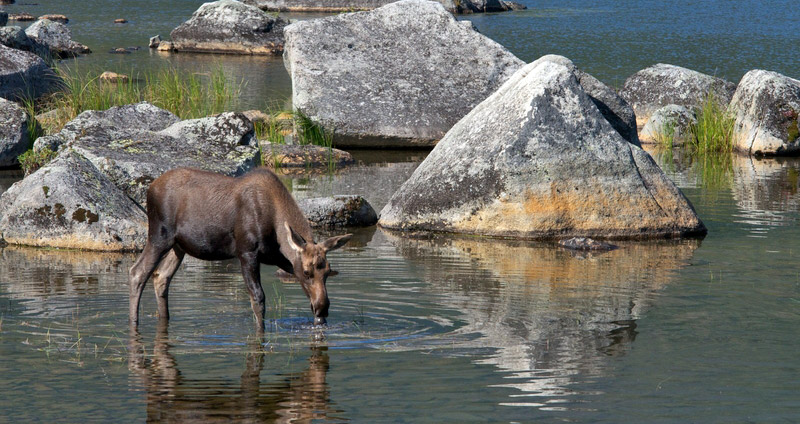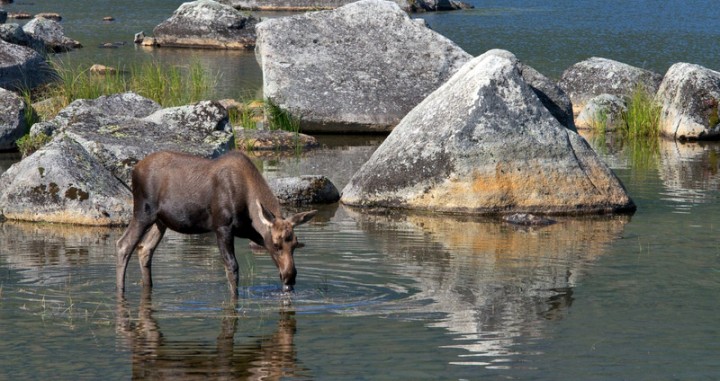Maine
Moose Safari | Spotting Maine’s Majestic Wildlife
We’re rounding a gentle meander on Socatean Stream, a remote and narrow tributary that empties into the wild northwest corner of Moosehead Lake. My guide is deftly piloting his pontoon boat up a winding and elusive channel edged with the bleached skeletons of ancient stumps and floating mats of rustling grasses. Even hard-core city dwellers […]

 We’re rounding a gentle meander on Socatean Stream, a remote and narrow tributary that empties into the wild northwest corner of Moosehead Lake. My guide is deftly piloting his pontoon boat up a winding and elusive channel edged with the bleached skeletons of ancient stumps and floating mats of rustling grasses. Even hard-core city dwellers instinctively know that this terrain is the lair of the moose. To visit Moosehead and not see a moose would be to go to Paris and not see the Eiffel Tower. To meet the demand, moose safaris have proliferated, with guides offering tours in search of moose via canoe, kayak, motorboat, pontoon, and floatplane.
We had just entered the stream, the big dappled waters of the lake still in view behind us, and there she was: a cow moose standing knee-deep in the marshy grass about 100 yards off, chewing contentedly on the river bottom. The moose spotted us at about the same time we spotted her. She hoisted her head and twitched her silly, rabbit-size ears, then concluded we were of little threat and resumed her breakfast. The scene was so still that my own camera shutter startled me.
Now, high overhead, a bald eagle streaks through the treetops, late for an appointment, its wings flapping forcefully and its body streamlined like a missile. So engulfing is my reverie that when we round a bend and come upon another moose—a majestic bull, with its rococo antlers still encased in the velvet of early summer—it takes a few moments for me to snap back to place.
The moose is on the far side of a low island and stands bolt upright as we float near in the lazy current. Tensing, the moose first trots, then breaks into a slow-motion gallop through the shallows, and makes his way with surprising nimbleness up a low embankment before vanishing into the dusky forest.
My guide sits back and watches, immensely comfortable in the large silence that follows.
We’re rounding a gentle meander on Socatean Stream, a remote and narrow tributary that empties into the wild northwest corner of Moosehead Lake. My guide is deftly piloting his pontoon boat up a winding and elusive channel edged with the bleached skeletons of ancient stumps and floating mats of rustling grasses. Even hard-core city dwellers instinctively know that this terrain is the lair of the moose. To visit Moosehead and not see a moose would be to go to Paris and not see the Eiffel Tower. To meet the demand, moose safaris have proliferated, with guides offering tours in search of moose via canoe, kayak, motorboat, pontoon, and floatplane.
We had just entered the stream, the big dappled waters of the lake still in view behind us, and there she was: a cow moose standing knee-deep in the marshy grass about 100 yards off, chewing contentedly on the river bottom. The moose spotted us at about the same time we spotted her. She hoisted her head and twitched her silly, rabbit-size ears, then concluded we were of little threat and resumed her breakfast. The scene was so still that my own camera shutter startled me.
Now, high overhead, a bald eagle streaks through the treetops, late for an appointment, its wings flapping forcefully and its body streamlined like a missile. So engulfing is my reverie that when we round a bend and come upon another moose—a majestic bull, with its rococo antlers still encased in the velvet of early summer—it takes a few moments for me to snap back to place.
The moose is on the far side of a low island and stands bolt upright as we float near in the lazy current. Tensing, the moose first trots, then breaks into a slow-motion gallop through the shallows, and makes his way with surprising nimbleness up a low embankment before vanishing into the dusky forest.
My guide sits back and watches, immensely comfortable in the large silence that follows.

